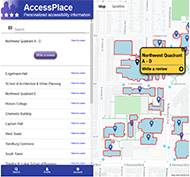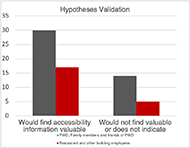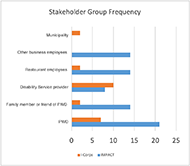AccessPlace Stakeholder Product Validation
L. M. O'Donnell![]() 1
1![]() , M. D. Drake
, M. D. Drake![]() 2
2![]() , R. O. Smith
, R. O. Smith![]() 3
3![]()
![]() 1
1![]() University of Wisconsin-Milwaukee,
University of Wisconsin-Milwaukee, ![]() 2
2![]() Rehabilitation Research Design and Disability Center
Rehabilitation Research Design and Disability Center
INTRODUCTION

As part of the Rehabilitation Research Design and Disability (R2D2) Center's R&D process, researchers regularly perform needs assessment research and participatory action research focus groups. Previous R2D2 studies have tested several hypotheses to better understand the need PWD have for public building accessibility information. In one study, 117 participants responded, with results supporting the need that PWD need accessibility information ahead of time to minimize barriers and that these individuals do not know where to acquire accessibility information [1, 2, 3].

Our AccessRatings for Buildings (ARB) project (see Figure 1), funded by the National Institute on Disability, Independent Living and Rehabilitation Research is a mobile and web-based system with a suite of apps that aims to provide up to date public building accessibility information for people with disabilities, their families, and building owners and employees. ARB leverages American Disability Association information and user experiences to disseminate useful information for individuals' specific needs.
One core application of ARB is called AccessPlace. AccessPlace is a web-based application designed for devices with a browser to create a place for users to share building accessibility information, enabling people with or without disabilities to more easily participate within the community (see Figure 2). The application uses a 5-star public building rating system with a comment section for users to complete. AccessPlace provides personalized accessibility information reports by prioritizing users' comments based on their selected impairment(s) and highlight building accessibility information most relevant to them. Using this application, people can identify accessible features before embarking within the community to individuals ahead of time to plan and alleviate potential barriers that would otherwise prevent them from participating within the community.
Although the ARB project has extensive years of prototyping and software development, the project's findings continued to lack in-depth data such as through interviews about the need from a user's experiential perspective. Therefore, the R2D2 Center applied to two entrepreneurial and assistive technology transfer oriented programs, National Science Foundation Southeastern I-Corps program and the University of Pittsburgh's IMPACT program, to find opportunities to advance our tech transfer directions.
BACKGROUND
At present, the R2D2 Center's ARB team is the first R&D team to complete both the National Science Foundation (NSF) I-Corps program and The University of Pittsburgh IMPACT program; both funded programs aimed to accelerate the assistive technology transfer process and knowledge translation. Through participation in the I-corps and IMPACT assistive technology transfer process, researchers inquired stakeholder perspectives on the need for the AccessPlace application. The IMPACT and the I-Corps programs were developed for researchers and entrepreneurs to perform customer discovery and a thorough up-front knowledge translation process better understand the potential stakeholders of new products. Customer discovery provides a methodology for researchers to test and validate hypotheses by interviewing consumers. Knowledge translation as an imperative component that provides a tool to conceptualize both evidence and practice [5, 6].
The R2D2 Center first participated in the Southeastern Wisconsin I-Corps program. I-Corps is a four-week program aimed to offer researchers and entrepreneurs the opportunity to explore their technologies through the lean launchpad methodology process. The lean launchpad methodology process utilized the business model canvas, customer discovery process, and minimal viable product. The customer discovery process is central to the program by challenging teams to conduct high-quality interviews while employing the elements taught throughout the program [5].
The second program R2D2 participated in was IMPACT Start Up, a virtual program hosted by the University of Pittsburgh Department of Rehabilitation Science and Technology and funded by the University of National Institute on Disability, Independent Living, and Rehabilitation Research (NIDILRR grant number 90DPKT0002). IMPACT provides guidance and tools for researchers and entrepreneurs to turn an idea into an impactful solution and assists them in identifying barriers and facilitators to successful technology transfer of assistive technology products into the marketplace [6]. IMPACT aims to train researchers and entrepreneurs in the customer discovery process as well as provide guidance in the assistive technology tech transfer process into the marketplace (University of Pittsburgh, 2020).
METHODS
Overview
A mixed-method study investigated the validity of AccessPlace through participation in two entrepreneurial programs. The entrepreneurial programs consisted of 4–12-week duration where mentor and coaching staff supported the ARB team towards accelerating the development of products. Researchers sought to test the following hypotheses in both entrepreneurial programs: 1) Individuals with disabilities would find restaurant accessibility information valuable prior to visiting a restaurant, and 2) restaurant owners and employees would be interested in accessibility information in order to engage in a new customer demographic. The I-Corps and IMPACT programs had several commonalities, including utilization of semi-structured interviews to inquire stakeholder perspective, mentorship opportunities, and educational sessions consisting of lecture and discussions. However, the programs had slightly different orientations.
Procedure of both entrepreneurial programs
Participants of the study in both entrepreneurial programs, were recruited through convenience and snowball sampling. Inclusion criteria for stakeholder participants included building employees, restaurant employees, disability service providers, PWD, and family members and friends of PWD. Interviewees recorded field notes during interview process including semi-structured questions with the ability to transcribe or write down pertinent quotations. Field notes of semi-structured interviews were analyzed using a five-step process: 1) removal of identifying information, 2) survey responses were iteratively reviewed while highlighting pertinent information and key words, 3) coding relevant information was placed into one of the eight categories if applicable, 4) common theme identified, 5) comparison of all interview transcripts. Coding occurred through utilization of a data sheet with eight columns including description of participant, type of impairment, frequency of eating out, how to select where to go, if they would find information valuable, types of social media used to acquire accessibility information, time they would spend using AccessPlace, and pertinent quotations from the interview. Aggregation and coding of data were completed by the primary author, a Doctor of Occupational Therapy, with six years of research experience, who has received special research training in both lecture and laboratory settings.
Southeastern Wisconsin I-Corps
Upon acceptance into the Southeastern Wisconsin I-Corps program, the ARB team selected an entrepreneurial lead (EL) and academic lead (AL) and additional interviewee team members. The ARB team selected a team of Master and PhD students in addition to the EL and AL to collect data. Team members went through weekly meetings of discussions and interview training to gain feedback and prepare for the interview process. Once accepted, the team was paired with an expert mentor for guidance throughout the program. During the program, the ARB team interacted with six other entrepreneurial groups accepted into the program.
The program implemented the Lean Launch methodology and customer discover process throughout the program's duration. As part of the customer discover process, teams were challenged to conduct interviews with primary stakeholders over the intense four-week program period. The I-Corps program specifically utilized the 'Mom Test' to guide the interview process. The 'Mom Test' required researchers to develop concrete questions to learn about the customer or topic of interest, while ensuring to not convey the project idea. Dissemination of work completed throughout the program included in-person presentations, group discussions and interactive exercises to explore project markets. Meetings occurred in person at the University of Wisconsin-Milwaukee Lubar Entrepreneurship Center.
Interview data was collected by all team members and results were recorded in a password locked excel spreadsheet. Information included in the spreadsheet were identifiers of the individual (name, role, organization, etc.) and a summary of their responses. Identifiers were kept and deemed important in order to categorize data and match particular stakeholders with specific needs and feedback. Throughout the program, weekly findings were discussed in presentations and feedback was provided for further improvement and direction for the following weeks. To ensure anonymity, all identifiers from interviews were removed. Data collected was entered into the launchpad system with removal of identifiers on a collaborative team board called LaunchPad Central which included a Business Model Canvas. On this platform the team was able to collaborate directly with business mentor to receive feedback and suggestions for future interviews. Additionally, the platform allowed researchers to organize hypothesis, stakeholder groups, as well as rate interviews on if they confirmed or denied specific hypotheses.
IMPACT Program
To participate in the University of Pittsburgh IMPACT program, entrepreneurial groups must complete the boot camp before acceptance in the Start UP program. During IMPACT Boot camp, the team received mentoring and live recitations consisting of presentations, Q&A, and lecture sessions occurred via video chat. After completion of the program, ARB applied and was accepted into to IMPACT Start Up program, where customer discovery training occurred with researchers consisting of rehabilitation technology.
Upon acceptance, the ARB team was provided with information regarding the Lean Launch methodology including readings from Business Model Generation and the Startup Owner's Manual. Teams were to also watch videos from steveblank.com and complete worksheets to gain more information on startup companies. IMPACT was open to describing product with purpose to identify how the product would be implemented within the desired audience and setting.
As part of the program, ARB was required to interview stakeholders and compile a presentation on findings to a larger group consisting of mentors and other IMPACT teams. Semi-structured interviews occurred over a 12-week period and were completed via phone, email, and video chat. The ARB team selected undergraduate, Master, and PhD students in addition to the EL and AL to collect data. Team members went through weekly meetings of discussions and interview training to gain feedback and prepare for the interview process. Each week, the team reflected on interviews, and the project supervisors provided insight on how to improve the interview process. Examples of interview questions were distributed to interviewers to prepare for interviews with specific stakeholder groups.
RESULTS

Results of the study revealed an overwhelmingly positive validation that PWD, family and friends of PWD, and Restaurant and other building employees would find accessibility information valuable and be interested in acquiring accessibility information (see Figure 3).

The IMPACT and I-Corps data sets totaled to 91 interviews: 20 individuals from I-Corps and 71 individuals from IMPACT (see Figure 4). One theme emerged from the data after inquiring stakeholders. Of the stakeholders identifying as PWD or family members and friends of PWD, they revealed an overwhelmingly positive rate of 68% interest in acquiring accessibility information prior to visiting a restaurant and restaurant.
During the interview process, 25% of IMPACT participants listed the time they would spend using the AccessPlace application, with a median of 7.5 minutes, indicating an area of further exploration. Additionally, the majority of stakeholders surveyed expressed they would write a review only for overwhelmingly positive or negative building experiences.
DISCUSSION
The R2D2 Center's experience with these two entrepreneurial programs broadened their perspective to interview more types of stakeholders. Researchers learned from the general approach and processes that were oriented toward customer discovery and using methodologies geared towards inclusion of PWD. R2D2 is still determining the best monetization strategies for AccessPlace and solidified the need to continue to seek stakeholder's expertise moving forward.REFERENCES
- Burns, S., Smith, R. O., Mendonca, R. ,. Pickens, N. D. (2017). Integrating A Participatory Design Approach: Developing Hestia With Multidisciplinary Perspectives. RESNA Annual Conference, New Orleans, LA. https://www.resna.org/sites/default/files/conference/2017/cac/Burns.html
- Smith, R. O., Drake, M. A. D., O'Donnell, L., Bauman, K., Sullivan, M., Pearson, S., Ives, C. & McGavock, K. (2020). Access ratings for buildings: Utilization of community engagement events to populate the database with accessible information. RESNA, Virtual Conference.
- Smith, R. O., Drake, M. A. D., Sullivan, M., Pearson, S., Ives, C. & McGavock, K. (2020). Access Ratings for Buildings: Piloting Community Engagement Events for Populating the Database with Accessibility Information for AccessPlace. OT Summit, Virtual Conference.
- Lencucha, R., Kothari, A., & Rouse, M. J. (2007). Knowledge Translation: A Concept for Occupational Therapy? American Journal of Occupational Therapy, 61(5), 593–596. https://doi.org/10.5014/ajot.61.5.593
- Southeastern Wisconsin NSF I-Corps Site – Milwaukee I-Corps Site. (2020). http://icorpsmilwaukee.org/
- University of Pittsburgh. (2020). IMPACT. IMPACT. https://idea2impact.org/